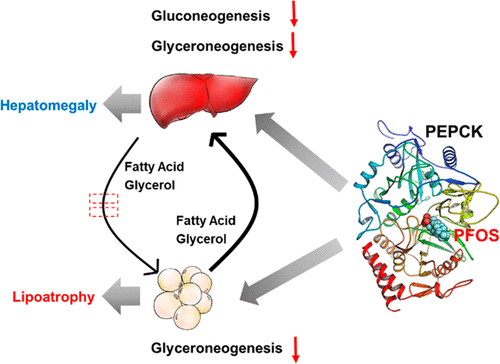当前位置:
X-MOL 学术
›
Environ. Sci. Technol. Lett.
›
论文详情
Our official English website, www.x-mol.net, welcomes your
feedback! (Note: you will need to create a separate account there.)
Perfluorooctanesulfonate Induces Hepatomegaly and Lipoatrophy in Mice through Phosphoenolpyruvate Carboxykinase-Mediated Glyceroneogenesis Inhibition
Environmental Science & Technology Letters ( IF 8.9 ) Pub Date : 2020-02-05 , DOI: 10.1021/acs.estlett.0c00048 Ling Wang 1 , Huiming Cao 1 , Zhen Zhou 1, 2 , Yu Pan 1 , Guangliang Liu 1 , Thanh Wang 3 , Yawei Wang 4 , Mingwei Xiao 1 , Siyi Chen 1 , Yong Liang 1
Environmental Science & Technology Letters ( IF 8.9 ) Pub Date : 2020-02-05 , DOI: 10.1021/acs.estlett.0c00048 Ling Wang 1 , Huiming Cao 1 , Zhen Zhou 1, 2 , Yu Pan 1 , Guangliang Liu 1 , Thanh Wang 3 , Yawei Wang 4 , Mingwei Xiao 1 , Siyi Chen 1 , Yong Liang 1
Affiliation

|
Perfluorooctansulfonate (PFOS) is a persistent organic pollutant that has attracted a great deal of attention due to toxic effects such as its lipid metabolism-disrupting potential. Exposure to PFOS can cause hepatomegaly and lipoatrophy in mice, but the underlying mechanisms are still unknown. Considering that glyceroneogenesis is the essential pathway for balancing the triglyceride (TG) cycle between liver and white adipose tissue (WAT), we speculate that PFOS acts via glyceroneogenesis inhibition to alter TG metabolism in the two tissues. Combining gene expression, protein expression, an enzyme activity assay, and molecular docking analysis, we report here that PFOS can interact with cytosolic phosphoenolpyruvate carboxykinase (PEPCK), the rate-limiting enzyme of glyceroneogenesis. Specifically, by repression of PEPCK, PFOS can inhibit the glyceroneogenesis process and thus decrease the glyceroneogenesis-derived glycerol level, leading to a reduced re-esterified TG level and causing atrophy in WAT. Moreover, in PFOS-exposed liver tissue, despite the fact that free glycerol and fatty acids released from WAT were being used for TG synthesis, the export of TG slowed. This eventually resulted in the continuous lipolysis of WAT and accumulation of lipid in the liver. PEPCK can be used as a key biomarker to assess the lipid metabolism disorders induced by other conventional and emerging per- and polyfluoroalkyl substances.
中文翻译:

全氟辛烷磺酸通过磷酸烯醇丙酮酸羧化激酶介导的甘油生成抑制作用诱导小鼠肝肿大和脂肪萎缩。
全氟辛磺酸盐(PFOS)是一种持久性有机污染物,由于其具有破坏脂质代谢的潜在毒性,因此受到了广泛的关注。暴露于全氟辛烷磺酸可引起小鼠肝肿大和脂肪萎缩,但其潜在机制仍不清楚。考虑到甘油生成是平衡肝脏和白色脂肪组织(WAT)之间的甘油三酸酯(TG)循环的必要途径,我们推测PFOS通过抑制甘油生成来作用以改变两个组织中的TG代谢。结合基因表达,蛋白质表达,酶活性测定和分子对接分析,我们在这里报告PFOS可以与胞浆磷酸烯醇丙酮酸羧化激酶(PEPCK)相互作用,这是甘油生成的限速酶。具体来说,通过压制PEPCK,全氟辛烷磺酸可以抑制甘油生成过程,从而降低源自甘油生成的甘油水平,从而导致重新酯化的TG水平降低,并导致WAT萎缩。此外,在暴露于PFOS的肝脏组织中,尽管从WAT释放出的游离甘油和脂肪酸被用于TG的合成,但TG的出口却减慢了。最终导致WAT持续脂解和肝脏中脂质的积累。PEPCK可用作评估其他传统和新兴的全氟烷基物质和多氟烷基物质引起的脂质代谢紊乱的关键生物标志物。尽管从WAT释放出的游离甘油和脂肪酸被用于TG的合成,但TG的出口却减慢了。最终导致WAT持续脂解和肝脏中脂质的积累。PEPCK可用作评估其他传统和新兴的全氟烷基物质和多氟烷基物质引起的脂质代谢紊乱的关键生物标志物。尽管从WAT释放出的游离甘油和脂肪酸被用于TG的合成,但TG的出口却减慢了。最终导致WAT持续脂解和肝脏中脂质的积累。PEPCK可用作评估其他传统和新兴的全氟烷基物质和多氟烷基物质引起的脂质代谢紊乱的关键生物标志物。
更新日期:2020-02-06
中文翻译:

全氟辛烷磺酸通过磷酸烯醇丙酮酸羧化激酶介导的甘油生成抑制作用诱导小鼠肝肿大和脂肪萎缩。
全氟辛磺酸盐(PFOS)是一种持久性有机污染物,由于其具有破坏脂质代谢的潜在毒性,因此受到了广泛的关注。暴露于全氟辛烷磺酸可引起小鼠肝肿大和脂肪萎缩,但其潜在机制仍不清楚。考虑到甘油生成是平衡肝脏和白色脂肪组织(WAT)之间的甘油三酸酯(TG)循环的必要途径,我们推测PFOS通过抑制甘油生成来作用以改变两个组织中的TG代谢。结合基因表达,蛋白质表达,酶活性测定和分子对接分析,我们在这里报告PFOS可以与胞浆磷酸烯醇丙酮酸羧化激酶(PEPCK)相互作用,这是甘油生成的限速酶。具体来说,通过压制PEPCK,全氟辛烷磺酸可以抑制甘油生成过程,从而降低源自甘油生成的甘油水平,从而导致重新酯化的TG水平降低,并导致WAT萎缩。此外,在暴露于PFOS的肝脏组织中,尽管从WAT释放出的游离甘油和脂肪酸被用于TG的合成,但TG的出口却减慢了。最终导致WAT持续脂解和肝脏中脂质的积累。PEPCK可用作评估其他传统和新兴的全氟烷基物质和多氟烷基物质引起的脂质代谢紊乱的关键生物标志物。尽管从WAT释放出的游离甘油和脂肪酸被用于TG的合成,但TG的出口却减慢了。最终导致WAT持续脂解和肝脏中脂质的积累。PEPCK可用作评估其他传统和新兴的全氟烷基物质和多氟烷基物质引起的脂质代谢紊乱的关键生物标志物。尽管从WAT释放出的游离甘油和脂肪酸被用于TG的合成,但TG的出口却减慢了。最终导致WAT持续脂解和肝脏中脂质的积累。PEPCK可用作评估其他传统和新兴的全氟烷基物质和多氟烷基物质引起的脂质代谢紊乱的关键生物标志物。











































 京公网安备 11010802027423号
京公网安备 11010802027423号